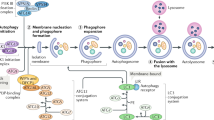
Overview
- Summarizes the latest research on aging biology from leading laboratories
- Discusses biological mechanisms of aging from molecular and cellular levels to physiological and systemic levels
- Covers important topics of biology of aging, focusing on the physiological changes of aging cells and tissues
Buy print copy
About this book
This book describes the recent advancement of basic research on the biology of aging and longevity studies in various organisms, as well as the neurobiology of aging and neurodegeneration mechanisms. Chapters present new findings and conceptual developments concerning the basic mechanisms of aging and longevity determination. As a follow-up volume to the previous book Aging Mechanisms (2015), it overviews the rapid progress of aging research introducing new topics from leading laboratories in Japan.
Chapter contributors are selected based on recent scientific achievements on the mechanisms of aging in various model organisms, including yeast, worm (C. elegans), fly (Drosophila), mice, and rats. Chapters are ordered from the discussion on molecular and cellular levels to physiological and systemic levels. The book also provides an overview of aging science in the region and helps readers quickly grasp who is doing what in this research area.
As the aging of population becomes an ever more pressing issue in Asia, advancing the understanding of basic mechanisms of organism aging and longevity determination will be crucial to developing more effective therapies and protective strategies. Researchers and graduate students in biomedical aging research will find this as a rich source of information and a stimulus to novel research directions.
Similar content being viewed by others
Keywords
Table of contents (25 chapters)
-
Front Matter
-
From Hypothesis to Mechanisms
-
Front Matter
-
-
Human Longevity: Accelerated Aging and Centenarians
-
Front Matter
-
-
Cellular Aging and Lower Animal Models
-
Front Matter
-
-
Metabolism: Factors Affecting Tissue Aging
-
Front Matter
-
Editors and Affiliations
About the editor
Nozomu Mori, Ph.D. graduated University of Tokyo, Faculty of Pharmaceutical Sciences, and obtained Ph.D. at the same school. His current position is Professor at Fukuoka International University of Health and Welfre, Faculty of Medicine, and Professor Emeritus of Nagasaki University. He was in the board member at Japan Gerontological Society and also at Japan Society of Biomedical Gerontology. Dr. Mori's scientific experties includes molecular cellular biology, neurobiology, and aging science. Dr. Mori previously directed laboratories at Andrus Gerontology Center at University of Southern California (USC) (1989-1995), JST-PREST (Sakigake) at Keihanna Plaza (1995-1997), Departmen of Molecuar Genetics at National Institute of Longevity Science (NILS) (1997-2004), JST-CREST at NILS (1997-2002), and Department of Anatomy and Neurobiology at Nagasaki University School of Medicine (2004-2019). He also served as University Library Director at Nagaski University (2013-2015) andalso in its Medical Branch (2009-2013). Dr. Mori is the founding organizer of international discussion forum on aging between Japan and Korea named Asian Aging Core for Longevity (AACL), which was supported by JSPS during 2010-2015. AACL is currently further developed as Asian Society for Aging Research (ASAR) among the East Asian nations incuding China, Hong Kong, and Taiwan.
Bibliographic Information
Book Title: Aging Mechanisms II
Book Subtitle: Longevity, Metabolism, and Brain Aging
Editors: Nozomu Mori
DOI: https://doi.org/10.1007/978-981-16-7977-3
Publisher: Springer Singapore
eBook Packages: Biomedical and Life Sciences, Biomedical and Life Sciences (R0)
Copyright Information: The Editor(s) (if applicable) and The Author(s), under exclusive license to Springer Nature Singapore Pte Ltd. 2022
Hardcover ISBN: 978-981-16-7976-6Published: 29 April 2022
Softcover ISBN: 978-981-16-7979-7Published: 30 April 2023
eBook ISBN: 978-981-16-7977-3Published: 28 April 2022
Edition Number: 1
Number of Pages: XVIII, 430
Number of Illustrations: 1 b/w illustrations
Topics: Neurosciences, Geriatrics/Gerontology, Human Physiology, Cell Biology



